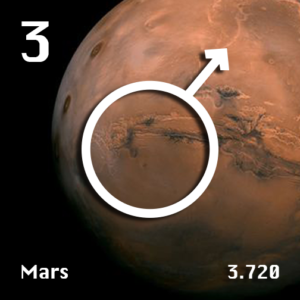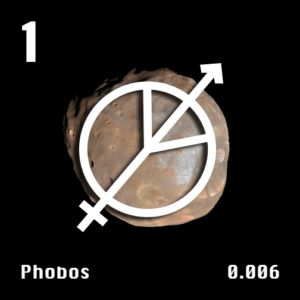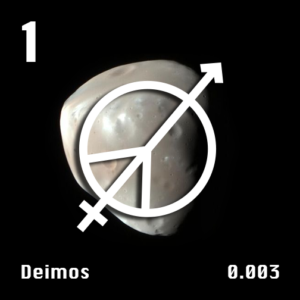The Martian System

Mars is the fourth-farthest planet from the Sun, directly after the Earth. It is also the second-smallest planet in the Solar System. Only Mercury is smaller than Mars is. Mars was named after a Roman god—the god of war because of its reddish color, which also is where it gets nicknamed the “Red Planet.” Mars gets its reddish color from iron oxides that dominate its surface.
Mar’s surface shares similar features with the Moon and the Earth, such as impact craters, valleys, mountains, and polar ice caps.
Those features include Mars’ most prominent peak, Olympus Mons, the largest volcano and second-highest known mountain in the Solar System, and the canyon, Valles Marineris, one of the largest canyons in our Solar System. The Borealis basin in the northern hemisphere covers 40% of the planet and may result from a giant impact feature.
The days and seasons of Mars are comparable to those here on Earth because the rotational period and the tilt of its rotational axis relative to the ecliptic are pretty similar.
Because Mars is our neighbor and similar to Earth in various aspects, it is the most explored solar system planet. SpaceX, a leading space organization in the U.S., was founded on the premises getting people to Mars. Scientists are currently assessing the habitability potential of Mars and the possibility of past life. We now have several astrobiology missions are planned, including the Mars 2020 and ExoMars rovers.
History of Mars
Mars has always been connected to various cultures and religions. The ancient Sumerians (ancient Babylonians) believed that Mars was Nergal, their god of war and plague. During those times, Nergal was an insignificance deity, with a cult centered at the city of Nineveh during later times. Mars was referred to as the “star of judgment of the fate of the dead” in Mesopotamian texts.
Ancient Egyptian astronomers recorded Mars as a wandering object in the night sky around 1534 BCE. The Egyptians were also familiar with retrograde motion, or the backward movement of a planet in the sky.
By the time of the Neo-Babylonian Empire, Babylonian astronomers were recording planetary motion and systematic observations of their apparent behavior in the sky. These astronomers knew that Mars made 37 synodic periods (periods against the backdrop of stars in the nighttime sky), precisely 42 circuits of the zodiac, every 79 years. Chineses and Indian texts mentioned Mars and its apparent motion through the sky throughout the fourth and five centuries.
By the 19th century, telescopes had evolved to the point in which Mars’s surface features were visible. In 1877, there was a time when it was closer to the Earth than usual. This allowed an Italian Astronomer to make a very detailed map of the surface of Mars.
Depending on when Mars was observed, there were many different ideas on how it was once on the surface. During seasonal changes, the polar ice caps would melt. Some people would believe that it was a planet that had tons of vegetation. People also thought that there were huge oceans on it. When smaller, less powerful telescopes were used, it appeared as though there were many different canals on the surface of Mars. Once the telescopes were able to be made more robust, those canals no longer appeared.
Surface Experience
Mars is one of the four terrestrial planets that are located within our solar system. This planet is made up of rock. The surface of this planet is actually made up of a type of basalt. Most of the surface is covered in oxide dust that is actually more or less just rust. There is no proper magnetic field on the planet. However, there is evidence that the poles of the planet were reversed at some time or other. This shows that there used to be a magnetic field.
Much of the planet’s surface shows evidence that it was hit very hard, which resulted in crater formations. There is proof that one impact site measures 6,600 miles by 5,300 miles. This takes up nearly 40% of the surface of the planet. One theory suggests that a planet almost the size of Pluto impacted Mars nearly 4 billion years ago.
Three different periods make up most of the physical surface of Mars. These three periods include the Noachian Period, the Hesperian Period, and the Amazonian Period. The first period seemed to have occurred between 4.5 and 3.5 billion years ago. This is also around the time when liquid water was available on the planet. The second period is thought to be when there was quite a bit of lava on the planet, as there used to be a great deal of volcanic activity. The last period appears to be the one where the least amount of change has occurred. The large mountain Olympus Mons was formed during this period.
The soil on the planet was extensively researched by the Phoenix lander. This soil appeared to be alkaline in nature. It was also rich in chlorine, potassium, magnesium, and sodium. These are the same nutrients that are found on the Earth and are necessary for plants to grow. Several streaks seem to just show up on the surface of the planet. This can be due to movement on the surface. It can also be due to other storms that may come upon the surface. Other theories suggest that there could be water on the surface, allowing colors to change.
Water can’t be on the surface of Mars since the atmospheric pressure is so low. However, the two polar caps have plenty of water ice. In 2008, the Phoenix lander actually sampled Martian water in the soil. Various landforms show water must have been on the surface of the planet at some time or other. Many different landforms suggest no longer any water, yet there used to be a significant amount somewhere on the planet for all of these various bodies to form.
There are even minerals that are located on Mars that only show up in the presence of water. There could be a tremendous amount of water located just underground on the planet. Rovers on Mars have shown evidence that there is water under the surface. This could be the reasoning behind the streaks observed from telescopes. During the Martian summer, water could thaw and create those streaks that are observed. They could then later re-freeze.
Exploration of Mars
Mars has only been explored remotely via spacecraft and probes. These explorations usually are geared towards understanding and learning how habitable this planet may be. Several of the missions that were supposed to go there ended up failing before anything happened.
There have been many different spacecraft that are still orbiting Mars and are still sending vast amounts of data back to Earth to be translated and used. Other rovers are still on the planet that is currently working on missions. They are checking to see how habitable the Martian surface is. They are also looking for traces of water. Some of the rovers are still exploring different craters.
Mars exploration began as early as the 1960s. The first successful flyby was by Mariner 4, which was owned by NASA. This was done in 1965. In 1971, Mariner 9 again initiated a flyby around the planet and sent back many data. NASA later sent Viking 1 and Viking 2 to the planet. This was in 1975. Viking 1 relayed information back for six years. Viking 2 relayed information back for three years. These two landers actually sent back color panoramic pictures of the Martian surface. Almost two-thirds of all attempts to explore Mars has failed. This has resulted in the planet gaining a rather negative reputation.
Active Missions to Mars
- The ExoMars Trace Gas Orbiter mission included a gas trace orbiter and an entry, descent, and landing module. The demonstrator module crashed after its descent to the Martian surface. This mission’s main goal was to search for various trace gasses that could be anywhere on the surface.
- MAVEN is another active mission on Mars. This one launched in 2013 and achieved orbit in 2014. MAVEN stands for Mars Atmospheric and Volatile Evolution mission. This mission has shed light on many questions that revolve around the habitability of this planet.
- MOM is also called the Mars Orbiter Mission. This is also known as India’s first Mars spacecraft, and it was actually successful with the first attempt. There are five instruments onboard. This spacecraft will remain in orbit and will take small readings.
- The popular rover Curiosity is a part of the Mars Science Laboratory mission launched. It landed in the Gale Crater. Curiosity has already discovered that this crater was once a part of a lake. It has also found organic material.
- Mars Reconnaissance Orbiter is currently in orbit around Mars. The mission of the MRO is to find evidence of past water sources on this planet. While searching for water, this orbiter also seeks to mark possible landing sites for future excursions on the planet’s surface.
- Mars Exploration Rover Opportunity & Spirit mission is considered one of Mar’s most successful missions, with the Opportunity & Spirit rovers being active on Mars for 14 years, from 2004 to 2018. The rover, nicknamed “Oppy,” covered almost 45 km of Mar’s surface during its exploration of Mars.
- Mars Express and Beagle 2 are still on Mars. The Mars Express is still fully functional. Beagle 2 has never been heard from once it attempted to reach the Martian surface. It has since detected methane and possible volcanic action.
Elon Musk Plans
Elon Musk has revealed plans that could quite possibly place nearly one million people on Mars within the next 40 to 100 years. The newest ideas revolve around a rocket that will be launched, sending 100 people up into orbit. The rocket will then return to earth, and land upright on the launching pad. It will then launch again, carrying the necessary fuel for the trip to the planet. It will meet the passengers in orbit, and the trip to Mars will begin.
The company has figured out multiple ways that it can go about saving money as well. The transport ship can actually capture old, unused satellites and bring them back down to Earth. It can also unload massive equipment that will need to be used in orbit around Earth. They also plan to re-use vehicles and rockets so that they won’t need to continue to create new ones. Musk wants to be able to land two different cargo ships on Mars by 2022. He also wants to be able to have humans on Mars by 2024.
Phobos and Deimos

Phobos is the innermost, irregularly shaped moon of Mars and larger of the two moons. It orbits at 3,700 miles away from Mars. This distance brings it closer to its planet than any other moon in the Solar System. Phobos is so close to Mars that it orbits Mars much faster than Mars rotates, completing an orbit in just 7 hours and 39 minutes. As a result, from the surface of Mars, it appears to rise in the west, move across the sky in 4 hours and 15 minutes or less, and set in the east, twice each Martian day.
Both Phobos and Deimos were discovered in 1877 by American astronomer Asaph Hall. Phobos has a radius of 7 miles and is seven times as massive as the outer moon, Deimos. Phobos is named after the Greek god Phobos, son of Mars and Venus and the personification of fear.
Deimos is the smaller and outermost of the two moons of the planet Mars. Deimos has a radius of 3.9 miles and takes 30.3 hours to orbit Mars at 14,580 miles. Deimos is non-spherical and consists of rock rich in carbonaceous material, similar to C-type asteroids.

It is cratered, but the surface is noticeably smoother than that of Phobos, caused by the partial filling of craters with regolith. Deimos was discovered by Asaph Hall, III at the US Naval Observatory in Washington, D.C. in 1877 and is named for Deimos, who in Greek mythology is the twin brother of Phobos and personifies terror.